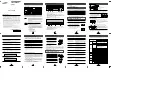
2.2. Securing the Stage to the Mounting Surface
DANGER: Mechanical Hazard!
Personnel must be made aware of the mechanical hazards during set up or when you
do service to the stage.
l
Do not manually move the stage if it is connected to a power source.
l
The stage must be mounted securely. Improper mounting can result in injury and
damage to the equipment.
l
When you move the tabletop manually to do maintenance, this could expose the
operator to internal pinch points. Refer to
on
DANGER
:
Magnetic Field Hazard!
When you move the tabletop manually to do
maintenance, this could expose the operator to the magnet track. Refer to
on
The mounting surface must be flat and have adequate stiffness to achieve the maximum
performance from the stage. When it is mounted to a non-flat surface, the stage can be distorted
while the mounting screws are tightened. This distortion will decrease overall accuracy. Adjustments
to the mounting surface must be done before the stage is secured.
Inspect the mounting surface for dirt or unwanted residue and clean if necessary. Use precision
flatstones on the mounting surface to remove any burrs or high spots. Clean the mounting surface
with a lint-free cloth and acetone or isopropyl alcohol and allow the cleaning solvent to completely
dry. Gently place the stage on the mounting surface.
IMPORTANT
: The stage is precision machined and verified for flatness prior to product
assembly at the factory. If machining is required to achieve the desired flatness, it
should be performed on the mounting surface rather than the stage. Shimming should
be avoided if possible. If shimming is required, it should be minimized to retain
maximum rigidity of the system.
Table 2-1:
Stage Mounting Surface Flatness Requirement
Stage Travel
Flatness Requirement
All Travels
1 µm per 50 mm
1. Verify that the shipping clamps are secure.
2. Remove the pneumatics cover. It is attached to the vertical angle bracket with four M3 button
head screws (
).
NOTE: [25 mm Travel Only] Manually lift the Z-Axis tabletop while sliding off the pneumatics cover
so that the cylinder rod end does not catch on the cover slot.
3. Mount the Z-Axis assembly using one of the available customer mounting patterns shown in
You can manually, but gently, move the base of the pneumatics cylinder to the left or
right to gain access to mounting holes in the vertical angle bracket. Use a long ball end T-handle.
Refer to
for screw torque specifications.
4. Reattach the pneumatics cover.
WARNING
:
Mechanical Hazard!
Do not operate the stage without the pneumatic
cover in place.
ANT95LZ Hardware Manual
2.2. Securing the Stage to the Mounting Surface
www.aerotech.com
23
Содержание ANT95LZ Series
Страница 1: ...Revision 2 01 ANT95LZ Series Single Axis Z Direct Drive Nanopositioning Stage HARDWARE MANUAL...
Страница 6: ...This page intentionally left blank List of Tables ANT95LZ Hardware Manual 6 www aerotech com...
Страница 16: ...This page intentionally left blank Handling and Storage ANT95LZ Hardware Manual 16 www aerotech com...
Страница 22: ...Figure 2 2 ANT95LZ 025 Dimensions 2 1 Dimensions ANT95LZ Hardware Manual 22 www aerotech com...
Страница 40: ...This page intentionally left blank 3 5 Motor and Feedback Phasing ANT95LZ Hardware Manual 40 www aerotech com...
Страница 48: ...This page intentionally left blank Appendix B Revision History ANT95LZ Hardware Manual 48 www aerotech com...
















































